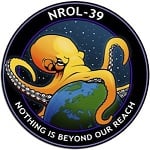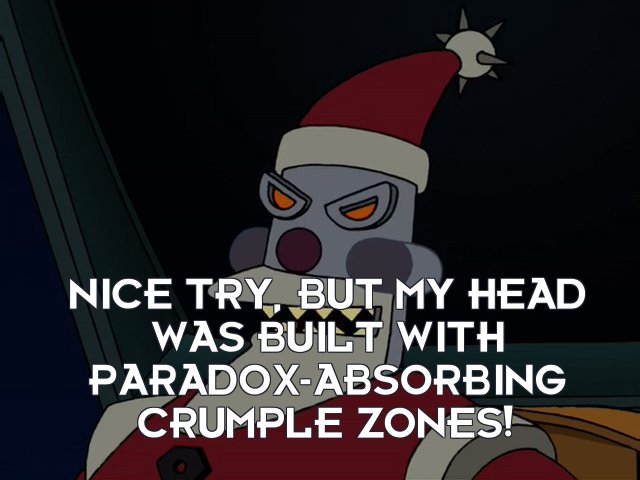B.
This is a multiple choice test. Once you eliminate three answers, you pick the fourth answer and move on to the next question. It can’t be A, C, or D, for reasons that I understand. There’s a non-zero chance that it’s B for a reason that I don’t understand.
If there is no correct answer, then there’s no point hemming and hawing about it.
B. Final answer.
I love this, it shows how being good at (multiple choice) tests doesn’t mean you’re good at the topic. I’m not good at tests because my country’s education system priorities understanding and problem solving. That’s why we fail at PISA
You think like I do. Bet you test well.
Entertaining response but I disagree.
I’m going to say that unless you’re allowed to select more than one answer, the correct answer is 25%. That’s either a or d.
By doing something other than guessing randomly (seeing that 1 in 4 is 25% and that this answer appears twice), you now have a 50% chance of getting the answer correct. However, that doesn’t change the premise that 1 in 4 answers is correct. It’s still 25%, a or d.
That’s an interesting perspective. The odds of correctly guessing any multiple choice question with four answers should be 25%. But that assumes no duplicate answers, so I still say that’s wrong.
I’m going to double down and say that on a real life test, this would likely represent a typo. In such case, I think you could successfully defend a 25% answer while a 60% answer is just right out the window, straight to jail.
The typo makes the answer incorrect. The whole question would need to be thrown out.
Fair enough
But some tests award bonus points if you get the thrown out question right by answering what it should have been!
Nice logic; poor reading comprehension.
Does better reading comprehension get you a better answer?
No of course not, but the question is more important to the answer than the “correct” answer.
Not in a multiple choice test
This isn’t a test. It’s a logic puzzle.
It’s not a puzzle. It’s just wrong.
“Which of the following is a mammal:
A) rock
B) time
C) verb
D) Enui”Is not a puzzle.
Based on previous guy’s logic: D.
I know A, B, and C are definitely wrong, but I’m not sure I fully understand D. So it’s D and move on.
Reality is I make a note and discuss with the teacher if they don’t notice themselves when tests come back.
You chose A, C, and D, so you have a 100% chance.
This is a self-referential paradox — a classic logic puzzle designed to be tricky. Let’s break it down:
Step-by-step analysis:
-
How many choices? There are 4 possible answers, so if we pick one randomly, the chance of picking any specific one is 1 in 4 = 25%.
-
How many answers say “25%”? Two.
-
That means the probability of randomly choosing an answer that says “25%” is 2 in 4 = 50%.
-
But if the correct answer is 50%, then only one option says “50%” — which is ©. So the probability of picking it at random is 1 in 4 = 25%, contradicting the idea that 50% is correct.
-
If the correct answer is 25%, then two options say that — a and d. So the chance of picking one of those at random is 50%, not 25% — again a contradiction.
-
Similarly, if 60% is correct (only one option), then the chance of picking it randomly is 25%, which again makes it incorrect.
Conclusion: Any choice leads to a contradiction. This is a self-referential paradox, meaning the question breaks logical consistency. There is no consistent correct answer.
Chatgpt ass answer lmao
haha yeah, I knew it at the “let’s break it down:”
I was like… I know this voice…“Conclusion:” was the final nail in the coffin
The motivation to do so confuses me. There’s no karma to farm here.
Why not? Here upvotes do the same as karma in reddit. Absolutely nothing.
Eh. On Reddit, karma was intended as an indicator of quality and authenticity. It was heavily flawed and abused by bots and propagandists.
It’s still providing a correct explanation to people, I guess
Got it right though
The © gave it away
That’s whatever browser or app you’re using. It rendered as © for me… Bracket, c, bracket
Well, parenthesis, and parenthesis, but yes
Parentheses can also be called (round) brackets, especially in the UK
ah, TIL, thanks
The em dash is a dead giveaway as well
I try to use em dashes when I can, but I think they’re used wrong in the comment above (IIRC they’re not supposed to be surrounded by spaces, but I could be wrong). What tips me off is the unambiguously “LLM” narrative voice and structure (“let’s break it down”, followed by an ordered list). Not that a human can’t type that, but sometimes it seems like ChatGPT is incapable of spitting out words in any other structure.
You’re right, en dashes would have been fine there. Em dashes don’t get spaced—and have specific grammatical uses too.
counter—point ; noone will accuse u of being a Ai if your grammer is shitte in a precise mannor , thou they will gouge ther I:s out when trying to reed it
actually come to think of it, aren’t homophones/alternate spellings a pretty good way to avoid AI stuff? since they have absolutely no concept of the sounds words make. though i suppose it’ll only work until the models get trained on that data…
I used to use em dashes all the time and now I find myself rethinking my writing styles because of people like you and it’s obnoxious.
AI has put me off writing lists.
I use em dashes all the time, but I don’t put a space on either side—I feel like that’s not the correct way to use one. If it is, I don’t wanna be correct.
I concur with this.
Heyo yee em—comrade
Y’all have got to stop this shit. Real people use real grammar.
Can’t tell if serious because entering ( c ) without the spaces is © in Firefox and other browsers.
Is it because the other letters don’t have brackets? I don’t use AI to know if that is a thing.
©
(c):O
deleted by creator
dontthinkaboutitdontthinkaboutitdontthinkaboutit
…so like, which one you picking?
E.
I would think that if you truly pick at random, it’s still a 25% chance no matter how you cut it
©
You had to show off, huh
The comment - which isn’t edited - uses
(c).Whatever client you use replaces/renders © [bracket c bracket] as ©.
Huh. I think it was just the web version of Lemmy. Weird choice by the Lemmy devs.
™
deleted by creator
-
The question is malformed and the correct answer isn’t listed in the multiple choices. Therefore the correct answer is 0%
If only one of the 4 options said 25% would it still be malformed#
No. The scenario asks you to consider a random selection, but the solution in that case is a certainty.
Loaded dice
deleted by creator
lol chill out there buddy it is only self-referential once. maybe twice.
I’m not certain, I think it’s an infinite loop.
I.E. If the answer is 25%, you have a 50% chance, if the answer is 50%, you have a 25% chance, if the answer is 25%, you have a 50% chance…
The only way out is to choose 60% to accept defeat
Haha, I think they should have made that option 0%, to further the paradox
Yeah, that’s right. https://en.wikipedia.org/wiki/Paradox
This is a paradox, and I don’t think there is a correct answer, at least not as a letter choice. The correct answer is to explain the paradox.
You can rationalize your way to exclude all but a last answer, there by making it the right answer.
Like, seeing as there are two 25% options, so there aren’t four different answers, which means there isn’t a 25% chance. This lead to there only being two options left 50% or 60%. This would seem to make 50% the right answer, but it’s not, because you know the options, so it’s not random, which in turn means you’re not guessing. So you have more that 50% chance of choosing the right answer. So 60% is the closest to a right answer, by bullshitting and gaslighting yourself into thinking you solved question.
Having been to school I know a teacher did not read this question so tge answer is probably A, B, C, or D. Chosen randomly of course. But you will get credit for 3/4 answers as long as you take the time to talk to the teacher during office hours.
It’s 0%, because 0% isn’t on the list and therefore you have no chance of picking it. It’s the only answer consistent with itself. All other chances cause a kind of paradox-loop.
Correct - even if you include the (necessary) option of making up your own answer. If you pick a percentage at random, you have a 0% chance of picking 0%.
Correct, including 0% as a part of the answers would make 0% a wrong answer.
I agree with 0% but disagree there’s any paradox - every choice is just plain old wrong. Each choice cannot be correct because no percentage reflects the chance of picking that number.
Ordinarily we’d assume the chance is 25% because in most tests there’s only one right choice. But this one evidently could have more than one right choice, if the choice stated twice was correct - which it isn’t. So there’s no basis for supposing that 25% is correct here, which causes the whole paradox to unravel.
Now replace 60% with 0%. Maybe that would count as a proper paradox. But I’d still say not really, the answer is 0% - it’s just wrong in the hypothetical situation posed by the question rather than the actual question.
Completely agree! In this case there is no real paradox, 0% is a perfectly consistent answer.
I think if you replace 60% with 0%, you’d get a proper paradox, because now there is a non-zero chance of picking 0% and it’s no longer consistent with itself. It’s similar to the “This statement is false” paradox, where by assuming something is true, it makes it false and vice versa.
It’s probably graded by a computer, and a) or d) is a fake answer, since the automated system doesn’t support multiple right answers.
I’m going to go with 25% chance if picking random, and a 50% chance if picking between a) and d).
If it’s graded by a human, the correct answer is f) + u)Many systems do allow multiple correct answers.
This can also be used a great example of proof by contradiction: There is no correct answer in the options. Proof: Assume there was a correct answer in the options. Then it must be either 25%, 50% or 60%. Now we make a case distinction.
(A) Assume it was 25. Then there would be two of four correct options yielding in a probability of 50%. Therefore 50 must be the correct answer. -> contradiction.
(B) Assume it was 50. Then there would be one of four correct options yielding in a probability of 25%. Therefore the answer is 25. -> contradiction.
© Assume it was 60%. Since only 0,1,2,3 or 4 of the answers can be correct the probability of choosing the right answer must be one of 0% 25% 50% 75% or 100%. -> contradiction.
Because of (A), (B) and ©, it cannot be 25, 50% or 60%. -> contradiction.
Cheeky answer - the correct answer is a superposition of 25% and 50%, thus you answer it as a multiple choice question
deleted by creator
My client renders this as ( c )
42
But what’s the question?
how many roads must a man walk down?
What is six times nine
Close, but nah, it’s the meaning of life
nuh uh, it’s the answer. to life, the universe, everything! Um, but what’s the question?
Pick a number. Any number.
Damn hitchhikers.
C, which means A or D, which means C, which means…
Lisa stays home?
This seems like a version of the Liar paradox. Assume “this statement is false” is true. Is the statement true or false?
There are a bunch of ways to break the paradox, but they all require using a system that doesn’t allow it to exist. For example, a system where truth is a percentage so a statement being 50% true is allowed.
For this question, one way to break the paradox would be to say that multiple choice answers must all be unique and repeated answers are ignored. Using that rule, this question only has the answers a) 25%, b) 60%, and c) 50%, and none of them are correct. There’s a 0% chance of getting the correct answer.
You can never answer this question correctly. If the correct answer is 25% there’s a 50% chance you guess correctly but that would make the 25% wrong.
But if the answer is the 50% then it implies that 25% is correct which implies that 50% is wrong.
We reach a contradiction for both 25% and 50% making the correct answer to make the whole statement truthy 0%.
50/50, you either guess it right or you dont
If you suppose a multiple choice test MUST ONLY have one correct answer:
-
Eliminate duplicate 25% answers
-
You are left with 60% and 50% as potential answers to this question.
-
C is the answer
If you were to actually select an answer at random to this question while believing the above, you would have a 50% chance of answering 25%.
It is obvious to postulate that: for all multiple choice questions with no duplicate answers, there is a 25% chance of selecting the correct answer.
However as you can see, in order to integrate the answer being C with the question itself, we have to destroy the constraints of the solution and treat the duplicate 25% answers as one sum correct answer.
Do you choose to see the multiple choice answer space as an expression of the infinite space of potential free form answers? Was the answer to the question itself an expression of multiple choice probability or was it the answer from the free form answer space condensed into the multiple choice answer space?
The question demonstrates arriving at different answers between inductive and deductive reasoning. The answer depends on whether we are taking the answers and working backwards or taking the question and working forwards. The question itself forces the inductive reasoning strategy to falter at the duplicate answers, leading to deductive reasoning being the remaining strategy. Some may choose to say “there is no answer” in the presence of needing to answer a question that only has an answer because we are forced to pick one option, and otherwise would be invalid. Some may choose to point out it is obviously a paradox.
-
What’s the correct value if the answer is not picked at random but the test takers can choose freely?
All answers are correct then.



















